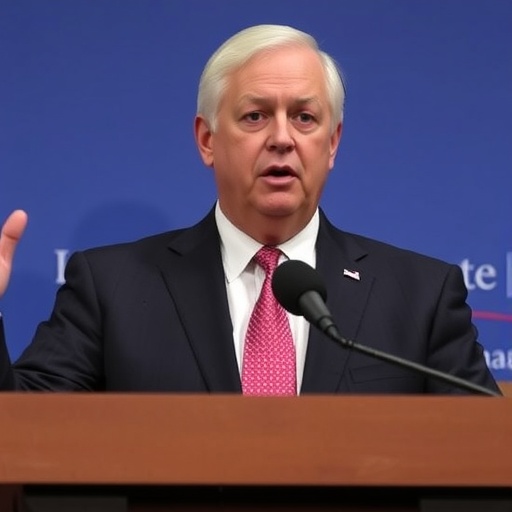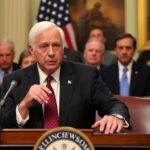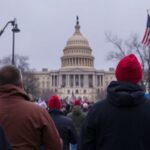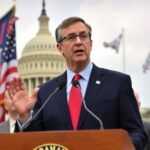In a tense address on the House floor today, Speaker Mike Johnson issued a stark warning that the ongoing Government shutdown could etch itself into American history as the longest ever, surpassing the 35-day mark set in 2018-2019. With negotiations grinding to a halt over Democratic demands to protect key healthcare provisions, the standoff is intensifying partisan divides and threatening vital federal services across the nation.
- Johnson’s Dire Prediction: Shutdown Could Eclipse 2018 Record
- Democrats Rally Against Proposed Healthcare Cuts in Shutdown Fight
- Economic Fallout Escalates as Federal Services Grind to a Halt
- Public Blame Game Intensifies with Bipartisan Finger-Pointing
- Glimmers of Hope: Potential Breakthroughs in Shutdown Negotiations
The impasse centers on proposed Republican-led budget cuts to health insurance programs, including potential reductions in Medicaid funding and Affordable Care Act subsidies. Democrats, led by Senate Majority Leader Chuck Schumer, have vowed to block any funding bill that doesn’t include safeguards for these programs, labeling the cuts as “devastating to millions of vulnerable Americans.” As the shutdown enters its 28th day, federal workers are furloughed, national parks remain closed, and the economic ripple effects are mounting, with estimates from the Congressional Budget Office projecting losses exceeding $10 billion if the crisis drags on.
Johnson’s Dire Prediction: Shutdown Could Eclipse 2018 Record
Speaker Johnson, R-La., didn’t mince words during his morning briefing, stating, “We’re on the brink of a catastrophe. This Government shutdown isn’t just a political game—it’s paralyzing our nation. If Democrats continue to obstruct, we’ll surpass the longest shutdown in history, and the American people will pay the price.” His comments come as the current impasse, triggered by a failure to pass a continuing resolution last month, shows no signs of abating.
Historically, the record for the longest U.S. Government shutdown stands at 35 days, from December 22, 2018, to January 25, 2019, during a dispute over border wall funding under then-President Donald Trump. That episode cost the economy an estimated $11 billion in lost productivity, according to a Government Accountability Office report. Today’s shutdown, now affecting over 800,000 federal employees and countless contractors, is already mirroring those impacts but with a twist: the battleground is healthcare, a politically charged arena that touches every corner of American life.
Johnson’s warning underscores the urgency within GOP ranks. House Republicans, holding a slim majority, have passed multiple funding bills that include the disputed healthcare cuts, aiming to rein in what they call “wasteful spending.” Yet, these measures have stalled in the Democrat-controlled Senate, where filibuster rules demand bipartisan support. “We’re willing to negotiate in good faith,” Johnson added, “but we can’t let one party’s extremism derail the entire government.”
Behind the scenes, sources close to the Speaker reveal mounting frustration. Internal GOP memos, leaked to reporters, highlight concerns that prolonging the shutdown could erode public support ahead of the 2024 midterms. Polls from Gallup show Republican approval ratings dipping to 38%, a five-point drop since the shutdown began, largely attributed to voter anger over delayed paychecks for essential workers.
Democrats Rally Against Proposed Healthcare Cuts in Shutdown Fight
At the heart of the government shutdown crisis lies a fierce debate over healthcare reforms. Democrats have drawn a red line, refusing to budge on Republican proposals that would trim $150 billion from Medicaid over the next decade and impose stricter eligibility for ACA marketplace subsidies. Senate Minority Leader Mitch McConnell, despite his party’s push, has privately urged compromise, but progressive Democrats like Rep. Alexandria Ocasio-Cortez are leading the charge against any concessions.
“These aren’t just numbers on a page—they’re lives on the line,” Ocasio-Cortez declared in a fiery speech yesterday. “Speaker Johnson’s healthcare cuts would strip coverage from 20 million low-income families. We won’t let that happen, even if it means fighting through this shutdown.” The Democratic strategy is clear: leverage the Senate’s power to force Republicans to the table, emphasizing the human cost of inaction.
Contextually, the proposed cuts stem from a broader Republican effort to offset tax cuts for corporations and high earners passed earlier this year. The Congressional Budget Office estimates that without modifications, these healthcare reductions could lead to 2.3 million Americans losing insurance by 2026. Democrats counter that such moves violate the spirit of the 2010 Affordable Care Act, which expanded coverage to 21 million previously uninsured individuals.
Negotiations have been fraught from the start. Initial talks in late October broke down when House Democrats rejected a GOP offer that preserved some healthcare funding but included unrelated riders on immigration enforcement. Since then, shuttle diplomacy between Capitol Hill leaders has yielded little progress. A bipartisan working group, formed last week under the auspices of the House Rules Committee, met for only 45 minutes before adjourning amid shouting matches over fiscal priorities.
- Key Democratic Demands: Full restoration of Medicaid expansion funds and no caps on ACA subsidies.
- Republican Counteroffers: Phased-in cuts with exemptions for rural hospitals and veterans’ programs.
- Sticking Points: Disagreements on how to measure “savings” without impacting patient care.
Experts like Dr. Elena Ramirez, a health policy analyst at the Brookings Institution, warn that the delay is already causing harm. “Hospitals are deferring non-emergency procedures, and community health centers are rationing services,” she told reporters. “This shutdown isn’t abstract—it’s closing doors on preventive care at a time when flu season is ramping up.”
Economic Fallout Escalates as Federal Services Grind to a Halt
The government shutdown‘s tentacles are reaching far beyond Washington, D.C., squeezing the U.S. economy in ways that could accelerate if negotiations fail. The Bureau of Economic Analysis reports a 0.2% dip in GDP growth for the fourth quarter, directly linked to furloughs and suspended contracts. Small businesses near federal installations, from Virginia’s defense hubs to California’s national labs, are reporting 15-20% revenue drops.
Federal employees, many working without pay under the assumption of backpay once resolved, are turning to food banks and credit cards. The National Treasury Employees Union estimates that 40% of affected workers have dipped into savings, with single parents hit hardest. In a poignant example, TSA screeners at major airports have called out sick en masse, leading to longer lines and travel disruptions during the holiday rush.
Speaker Johnson acknowledged the strain in his address, saying, “No one wins in a government shutdown. Our brave service members, air traffic controllers—they’re the real victims here.” Yet, blame is flying both ways. A recent Pew Research Center survey found 52% of Americans faulting Democrats for the stalemate, up from 45% last week, while 48% point to Republicans—evidence of a polarized public weary of the drama.
On the healthcare front, the shutdown’s impact is acute. The Centers for Disease Control and Prevention has halted routine disease surveillance, potentially blinding officials to emerging outbreaks. Medicare and Medicaid reimbursements are delayed, forcing nursing homes to lay off staff. The American Hospital Association has penned an open letter to Congress, signed by 4,000 executives, urging swift resolution: “Every day this continues, patients suffer.”
- Immediate Effects: Over 2,000 research grants paused, stalling cancer and opioid studies.
- Longer-Term Risks: Credit rating agencies like Moody’s warn of a potential U.S. downgrade if the shutdown exceeds 40 days.
- Global Repercussions: International partners, including NATO allies, are questioning U.S. reliability amid frozen foreign aid.
Economists project that each additional week could cost $2.5 billion, compounding inflation pressures already at 3.1%. Wall Street reacted sharply, with the Dow Jones dropping 1.2% on news of stalled negotiations.
Public Blame Game Intensifies with Bipartisan Finger-Pointing
As the government shutdown wears on, both parties are scrambling to shape the narrative, but public frustration is boiling over. Social media is ablaze with hashtags like #EndTheShutdown and #HealthcareFirst, amplifying stories of affected families. A CNN poll reveals 65% of voters view the crisis as “unacceptable,” with independents—key to future elections—tilting toward Democrats by a 10-point margin for their healthcare defense.
Speaker Johnson has taken to cable news circuits, framing Democrats as “obstructionists” beholden to “radical left-wing demands.” In one interview on Fox News, he quipped, “We’ve offered olive branches; they’ve responded with thorns.” Democrats, meanwhile, are running ads in swing districts highlighting GOP healthcare proposals, with taglines like “Don’t Let Them Take Your Coverage.” House Minority Leader Hakeem Jeffries accused Johnson of “grandstanding” to appease his party’s hardliners.
The blame extends to past precedents. During the 2013 shutdown over the ACA itself, public opinion swung against Republicans, costing them seats in 2014. Today, similar dynamics are at play. Veteran analysts like Norman Ornstein of the American Enterprise Institute note, “This shutdown is a high-stakes gamble. If it breaks the record, the party in power—Republicans in the House—will bear the brunt.”
Grassroots movements are mobilizing. Unions representing federal workers have staged rallies outside the Capitol, drawing thousands. In Michigan, a single mother furloughed from the IRS shared her story with local media: “I can’t afford my son’s insulin without pay. This isn’t politics; it’s survival.” Such testimonials are fueling calls for third-party mediation, though Speaker Johnson dismissed the idea as “unnecessary interference.”
Glimmers of Hope: Potential Breakthroughs in Shutdown Negotiations
Despite the gloom, whispers of progress in negotiations offer a faint light at the tunnel’s end. Backchannel talks between moderate Republicans and centrist Democrats, facilitated by the Problem Solvers Caucus, are exploring a compromise: scaling back healthcare cuts to $75 billion while tying them to bipartisan infrastructure investments. Senate leaders from both sides have scheduled a rare joint session for tomorrow, signaling a possible thaw.
Speaker Johnson hinted at flexibility, telling reporters, “We’re not married to every detail. If Democrats meet us halfway on fiscal responsibility, we can end this government shutdown and get America back to work.” On the Democratic side, Schumer echoed the sentiment: “Healthcare is non-negotiable, but we’re open to creative solutions that protect families without bankrupting the future.”
Looking ahead, experts predict a resolution could come within days if cooler heads prevail, potentially averting the historic milestone. However, failure risks cascading effects: delayed tax refunds in January, strained Social Security processing, and eroded trust in institutions. The White House, through Press Secretary Karine Jean-Pierre, has urged unity: “This shutdown harms everyone. Congress must act now.”
As negotiations resume, the stakes couldn’t be higher. A breakthrough would restore normalcy and bolster economic confidence; prolonged deadlock could redefine political fault lines for years. With the nation watching, the coming week will test whether bipartisanship can triumph over division in safeguarding healthcare and fiscal stability.









